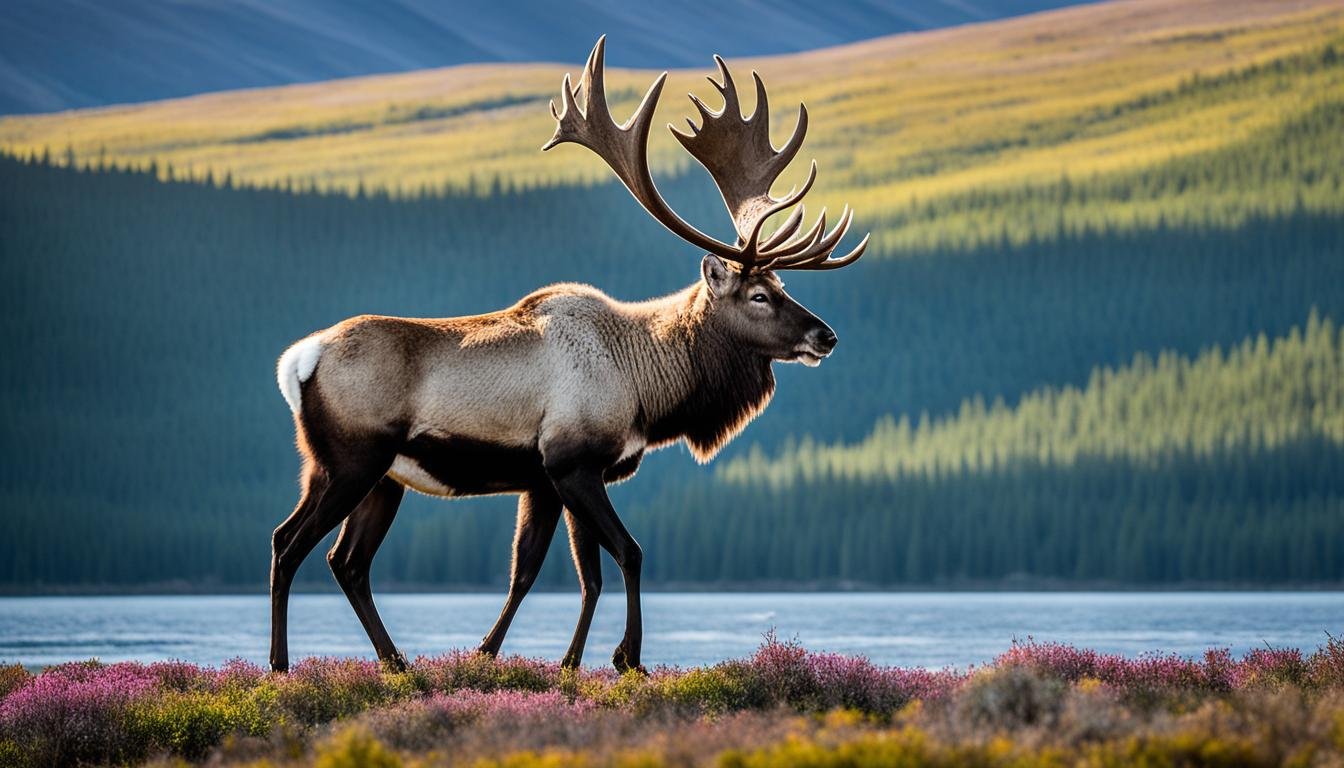Ever thought about seeing caribou in their natural setting?
Canada has some top spots for this, each offering a unique chance to see these amazing animals in beautiful places. You’ll find them in everything from peaceful national parks to remote wilderness areas.
This guide will show you the best places to see caribou and share interesting facts about their lives and how they move.
Key Takeaways about Caribou Viewing Locations
- Canada hosts three different caribou populations: Woodland, Mountain, and Barren-ground.
- National parks like Jasper and Banff are well-known for their caribou viewing opportunities.
- Woodland Caribou Park has over 1,000 backcountry campsites available for exploration.
- Caribou populations face threats from habitat loss and climate change.
- Research and conservation efforts are ongoing across multiple national parks to protect caribou herds.
Introduction to Caribou and Their Habitat
Caribou, or Rangifer tarandus caribou, are part of the deer family. They are famous for their big antlers and size. These animals weigh between 175 to 400 lbs and live in the far north.
They love to eat grasses, leaves, lichens, and mushrooms. Caribou have big hooves that act like snowshoes. This helps them move through deep snow to find food.
These animals live in places like the arctic tundra, mountain tundra, and northern forests. In late fall, they come together in big groups. This makes them easier to see at caribou observation sites.
Protecting their homes is key to their survival. Caribou are threatened by habitat loss and climate change. They are listed as threatened under Canada’s Species at Risk Act. We need to keep working on conservation to make sure they can still be seen in the future.
Understanding Caribou Migration Patterns
Caribou migration is key to their survival. Every year, they move to find food and avoid predators. The Qamanirjuaq herd, with over 300,000 caribou, shows this journey well, moving between summer and winter grounds.
Many people go to see caribou migration. It starts in March or April, pushed by big climate changes. The herds begin together but arrive at their summer grounds at different times, depending on the weather the year before.
Insects affect their migration too. If there are more insects, it can make them wait to reach their summer grounds. This shows how caribou are sensitive to climate change, especially warmer summers in the Arctic.
New technology helps track caribou during their migration. Since 1993, satellite collars have tracked the Qamanirjuaq herd. Now, GPS collars give exact locations, helping researchers understand their paths better. This info helps find the best places to see caribou.
Top Caribou Viewing Locations in Canada
For wildlife lovers and those looking for amazing nature experiences, Canada’s national parks are perfect. These places are great for seeing caribou in their natural setting.
Jasper National Park
Jasper National Park is known for its beautiful landscapes and diverse wildlife. The southern mountain caribou live in hidden areas, like the Tonquin Valley and Brazeau Mountain ranges. Thanks to conservation efforts, their homes are protected, helping their numbers stay stable.
Even though there are only about 49 to 55 Tonquin caribou and less than 10 Brazeau caribou left, you might still see them.
Banff National Park
In Banff National Park, seeing caribou is easy, especially in June during calving season. They can be seen eating in the wide open spaces. The park helps caribou migrate, making it a great place to watch them.
The park’s beautiful views make seeing caribou even more special.
Wood Buffalo National Park
Wood Buffalo National Park has one of the biggest wild caribou herds in North America. During their migrations, it’s easy to spot these amazing animals. The park’s vast wilderness supports a healthy caribou population and offers stunning views.
This park is one of the best places to see caribou in Canada, offering unforgettable nature experiences.
Prime Caribou Watching Areas in Northern Canada
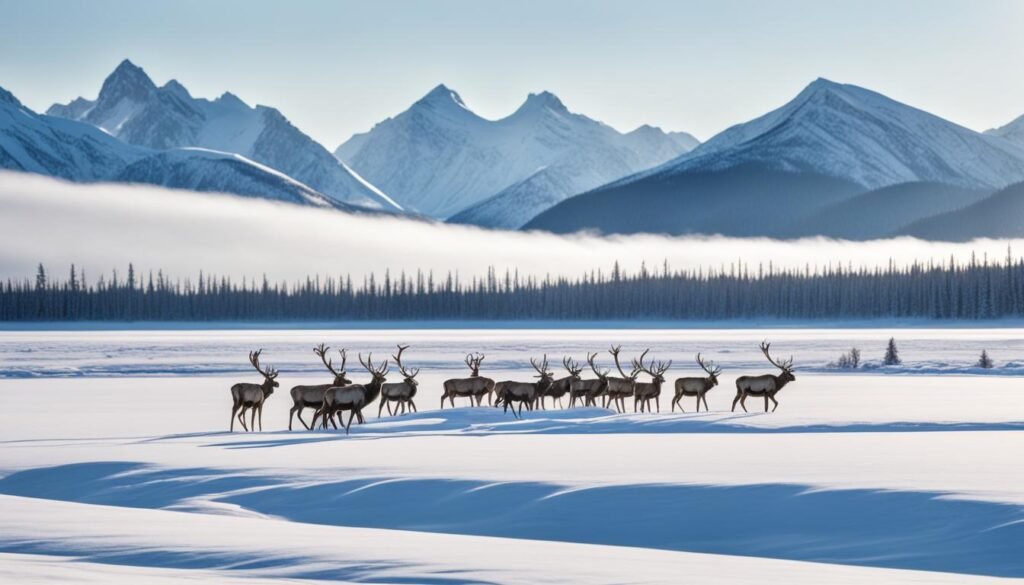
Northern Canada is a top spot for caribou fans. It has some of the most beautiful places to see caribou in the wild. Two areas are especially great for watching these animals and are easy to get to.
Arctic Haven Wilderness Lodge
The Arctic Haven Wilderness Lodge is on Ennadai Lake. It’s a perfect spot for caribou watching. The lodge offers comfortable accommodations and amazing views of wildlife. Guests can explore the wild and see many caribou migration spots.
There are lots of caribou here. So, visitors can see them up close during their migration.
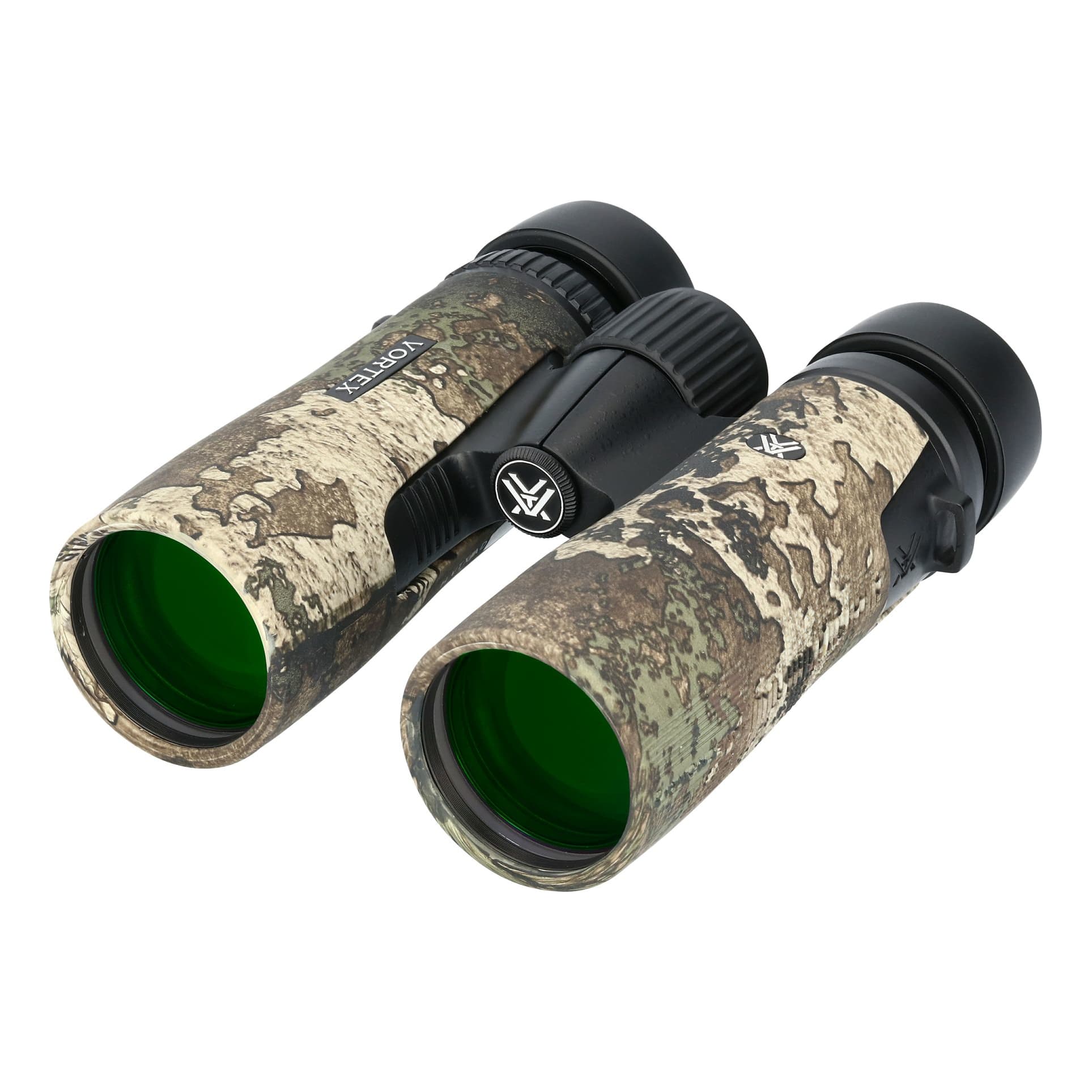
Qamanirjuaq Migration Routes
The Qamanirjuaq migration routes are a must-see for caribou fans. This journey shows thousands of caribou moving across the land. It’s an experience you won’t forget.
The scenery is beautiful, and you can see big herds of caribou. It’s a key spot for watching caribou migration.
If you like wildlife and fishing, check out prime fishing spots in Canada. You can enjoy the beauty of nature while helping to protect it for the future.
Caribou Habitat Locations in Western Canada
Western Canada is home to many caribou habitats crucial for their survival. These habitats range from vast old-growth forests to tough alpine areas. In British Columbia, there are 54 unique subpopulations, each with its own territory based on their needs.
The boreal caribou, listed as “threatened,” live in five areas in the northeast. These places are key for their food, giving birth, and moving. The Northern Mountain caribou have 17 areas in British Columbia and are considered “special concern.” The Southern Mountain caribou are also divided into three groups, with 18 areas, all “threatened.”
Caribou don’t just live in core areas but also in the lands around them. These areas affect their way of life. Laws like the Land Act and the Forest and Range Practices Act help protect these habitats.
- Population Monitoring: Regular counts of the 54 herds help track their numbers.
- Habitat Protection: Protecting at least 65% of boreal caribou habitats is key to their recovery.
- Impact of Human Activity: More predators and habitat damage from fires threaten these animals.
- Legislative Framework: Laws protect caribou habitats from people and harm to the environment.
Setting up caribou observation sites helps us learn more about these amazing animals. Keeping their homes safe means protecting the complex ecosystems they live in. This balance is crucial for both the caribou and the environment.
| Caribou Type | Status | Herd Range Areas |
|---|---|---|
| Boreal Caribou | Threatened | 5 |
| Northern Mountain Caribou | Special Concern | 17 |
| Southern Mountain Caribou | Threatened | 18 |
Where to Watch Caribou During Migration
To see the amazing caribou migration, you need to know the best times and places. Spring and fall are the best seasons to watch as they move between their summer and winter homes. Look for them in national parks and the Rockies, where they gather in large numbers.
For a closer look, consider joining guided tours in northern Alaska. These tours let you see over 60,000 caribou up close. The Western Arctic Herd is easier to spot on river trips, while the Porcupine Herd is often seen in the Arctic National Wildlife Refuge in early July.
In late June and early July, after they give birth, caribou gather in big groups. In autumn, the Brooks Range is a great place for photos. You can see caribou in groups of 10 to 50 moving south through the mountains.
Even in winter, you might see caribou when the tundra is covered in snow. Special trips to the Arctic National Wildlife Refuge are a good way to see them. These trips let you see caribou up close and learn about their behavior. This is especially true during the late October rut and spring migration.
For more info on where to see caribou, check out guides and tours that make your visit better. For detailed info on where to go, see this guide on caribou viewing spots. Winter can be tough, but with the right timing, you can see amazing things in the wild.
Caribou Sightseeing Spots Worth Visiting
Exploring caribou can be exciting for those who love wildlife. In Canada, many places let you see caribou outside national parks. The Northwest Territories and northern Manitoba are top spots for this, thanks to easy access.
Crooked Lake Resort is near Horsefly in the Cariboo Mountains of British Columbia. It offers cozy stays and leads to outdoor fun. This makes it a great spot for watching caribou. The stunning views add to the charm, making it perfect for seeing caribou in the wild.
Tweedsmuir Provincial Park is another great place. Here, you might see grizzly bears and caribou. The Gold Rush Trail mixes history with nature. It shows off the 1860s town of Barkerville and offers activities like fishing and horseback riding.
Working with local groups can give you tips on where to see caribou all year. These groups often have programs that teach about caribou and why we need to protect them.
Visitors can enjoy everything from exciting adventures to peaceful walks. Canada’s caribou population is a big draw for many. These spots let you see the animals and connect with Canada’s natural beauty.
Responsible Wildlife Observation Practices
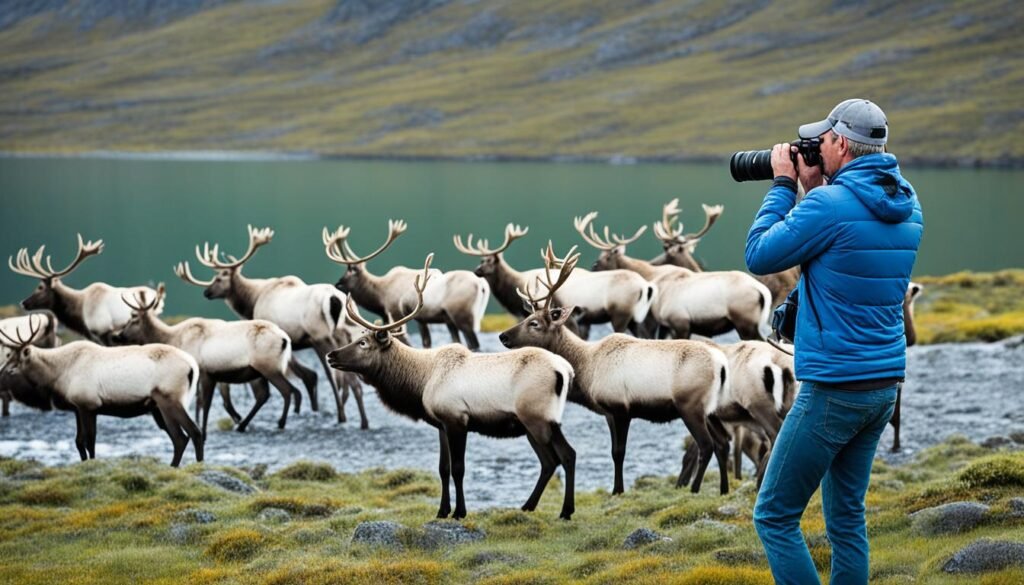
When visiting caribou observation sites, it’s key to follow responsible wildlife observation practices. Keep a respectful distance from the herds to avoid disturbing them. Getting too close can stress the caribou and change their natural ways, which is bad for them.
Being quiet while you watch helps protect the animals and makes the experience better for everyone. By sticking to rules that protect caribou habitats, visitors help keep these amazing animals around. This way, humans and caribou can live together peacefully in their homes.
Teaching visitors about how human actions affect wildlife is crucial for a sustainable environment. Showing how fragile caribou populations are stresses the need for careful watching of wildlife. These efforts are key to saving caribou and their homes for the future.
Conservation Efforts for Caribou Populations
Canada is key in saving caribou, facing issues like habitat loss and climate change. In northeastern British Columbia, the Pink Mountain caribou range covers 958,000 hectares.
This shows how big the areas we need to protect are. Plans are being made to fix about 13,000 kilometers of damaged land, focusing on 9,000 kilometers that can be fixed.
The Southern Group of Southern Mountain caribou stretches from Prince George to southeastern British Columbia, with 18 herds.
These herds have about 42,308 kilometers of damaged land to fix. The Central Group, with herds like Narraway and Quintette, has 10,335 kilometers ready for action. These efforts show how we’re working to keep caribou safe and their homes intact.
Stopping threats to caribou requires teamwork between Parks Canada, Indigenous peoples, and conservation groups. They’re working to protect these amazing animals.
Places like Ivvavik and Vuntut National Parks in the Yukon are key for caribou breeding and migration. Using aerial surveys and DNA studies helps us understand and predict changes in caribou numbers, guiding our conservation work.
These conservation efforts are crucial for caribou survival and the health of the ecosystem. By protecting their homes, Canada is fighting against human harm and changes in nature. This ensures a future for these vital species.
For more info on conservation efforts, visit conservation strategies for caribou populations.
| Caribou Population | Range Area (Hectares) | Linear Disturbances (Kilometers) | Restoration Potential (Kilometers) |
|---|---|---|---|
| Pink Mountain | 958,000 | 13,000 | 9,372 |
| Southern Group | N/A | 42,308 (high and moderate priority) | N/A |
| Central Group | N/A | 10,335 | N/A |
Conclusion
Canada is a great place for seeing caribou in the wild. Places like Jasper National Park and the Arctic Haven Wilderness Lodge show how caribou live.
But, these areas face big challenges from human activities and climate change, which harm caribou numbers.
We need to work on saving caribou for the future. The goal is to keep 65% of their homes safe. But in Alberta, over 90% of their land is already changed. By being careful and supporting conservation, we can help protect these animals.
Understanding how climate change affects caribou and supporting local efforts is key. As we enjoy Canada’s wild beauty, let’s focus on keeping caribou and their homes safe. This way, they can continue to be a symbol of Canada’s wildlife for years to come.
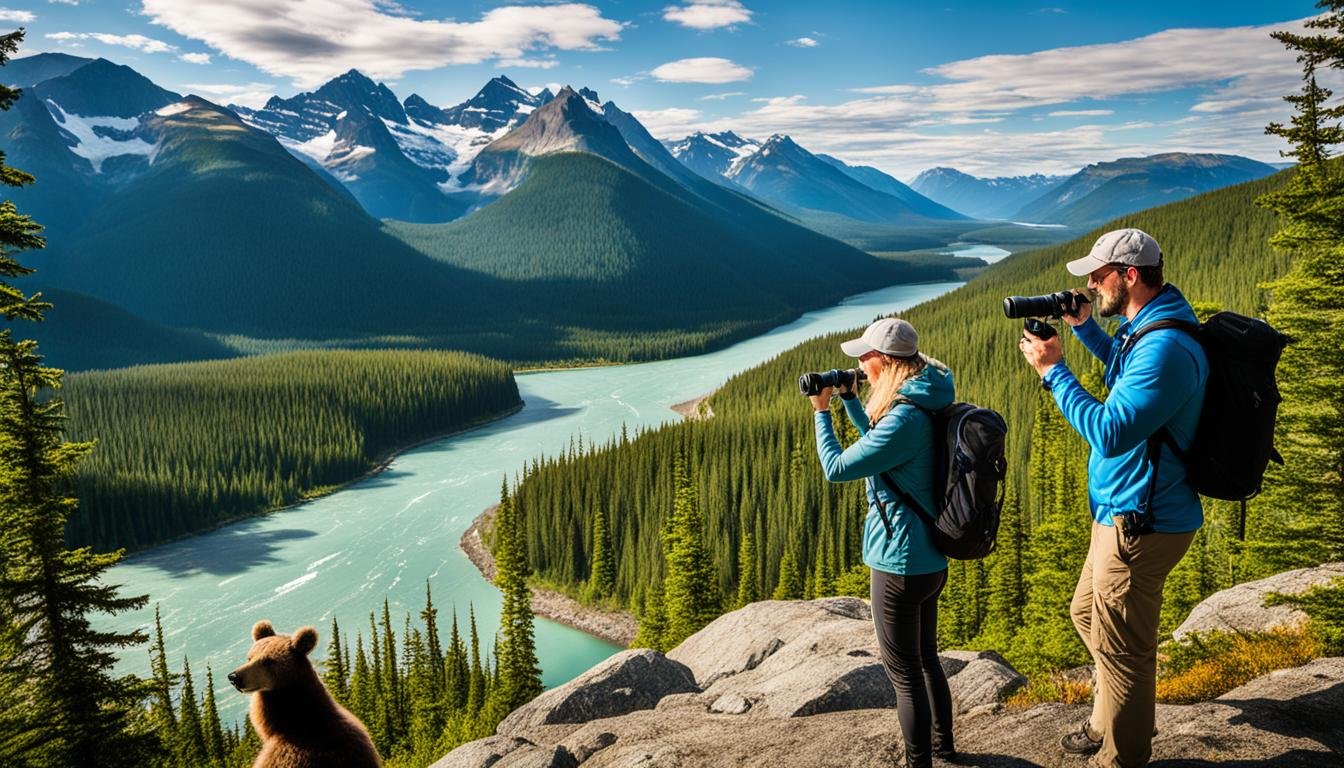
FAQ
Where are the best places to see caribou in Canada?
The top spots for caribou sightings are in Jasper National Park, Banff National Park, and Wood Buffalo National Park. These parks are famous for their caribou migrations.
What are some key caribou migration spots?
Important places for caribou migration include the Qamanirjuaq routes. Here, over 300,000 animals move between their summer and winter homes.
When is the best time to observe caribou during migration?
Spring and fall are the best seasons to see caribou. They move between their summer and winter feeding grounds then.
Are there specific caribou observation sites for tourists?
Yes, tourists can visit special caribou watching spots. These include viewpoints in national parks and eco-lodges with guided tours.
How can I engage in responsible wildlife observation practices while watching caribou?
To watch caribou responsibly, stay far away, be quiet, and don’t get too close. Always follow rules to protect their homes.
What conservation efforts are in place for caribou populations?
Conservation efforts help protect caribou. This includes saving their homes, watching over herds, and recovery plans by Parks Canada. They tackle habitat loss and climate change.
Can you recommend any specialized eco-lodges for caribou viewing?
The Arctic Haven Wilderness Lodge is a top choice for caribou watching. It’s on Ennadai Lake and offers great views of the Qamanirjuaq migration.
Where can I find information about caribou habitat locations?
Learn about caribou habitats from wildlife groups, national parks, or local tour operators. They know a lot about animal movements and behaviors.
How do climate change and human activities affect caribou migration?
Climate change and human actions can change caribou habitats, affect their food, and block their paths. That’s why saving them is so important.
Are there specific regulations for viewing caribou in national parks?
Yes, national parks have rules to protect wildlife. These include keeping a safe distance, being quiet, and respecting nature. Visitors should follow these rules for safe and respectful watching.
